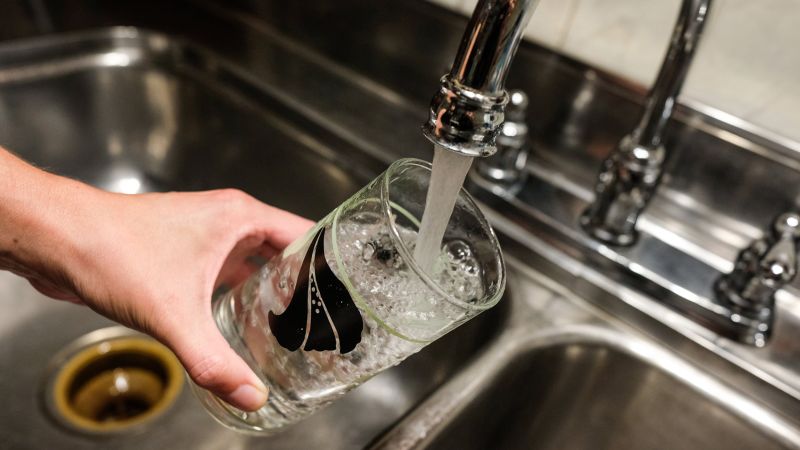Biden administration sets first national standard to limit ‘forever chemicals’ in drinking water | CNN
Biden administration sets first national standard to limit ‘forever chemicals’ in drinking water CNN


Sustainable Development Goals (SDGs): Biden Administration Finalizes National Standard to Limit “Forever Chemicals” in US Drinking Water

CNN
—
The New National Standard
The Biden administration has finalized the first national standard to limit the presence of dangerous “forever chemicals” in drinking water across the United States. This new rule, considered a “huge breakthrough” by environmentalists, aims to protect human health and aligns with the Sustainable Development Goals (SDGs).
The standard, which is legally enforceable, focuses on reducing exposure to per- and polyfluoroalkyl substances (PFAS), commonly known as “forever chemicals.” Water utilities will now be required to filter out five specific types of PFAS, including PFOA, PFOS, PFNA, PFHxS, and HFPO-DA (GenX chemicals). The regulations also establish limits for mixtures of certain PFAS chemicals.
The Impact of “Forever Chemicals”
PFAS are synthetic chemicals widely used to repel water and oil. However, they persist in the environment and accumulate in the human body, posing significant health risks. These chemicals have been linked to various health problems, including cancer, thyroid disease, reproductive issues, and organ damage. According to the US Centers for Disease Control and Prevention, PFAS are present in the blood of nearly 97% of all Americans.
In 2022, the US Environmental Protection Agency (EPA) issued health advisories highlighting the greater hazards of PFAS to human health than previously believed. These chemicals are considered dangerous even at levels thousands of times lower than previously thought.
Addressing the Gap: Federal Standard for Drinking Water
Until now, there was no federal standard regulating the presence of PFAS in drinking water. Only a few states had passed laws requiring water utilities to test and filter out these chemicals. The new national standard will significantly reduce PFAS exposure for approximately 100 million people in the United States.
Water treatment facilities will have three years to test for PFAS and two years to implement filtration technologies if the chemicals exceed the standard. Public water systems must also inform consumers about the levels of PFAS in their drinking water.
New Standards and Investments
The new regulations establish different standards for various PFAS chemicals. For PFOA and PFOS, the maximum contaminant levels (MCLs) will be set at 4.0 parts per trillion individually. The new maximum contaminant level goal for PFOA and PFOS will be zero, reflecting the latest research indicating that any exposure to these chemicals carries risks.
The EPA will set the contaminant level for PFNA, PFHxS, and GenX chemicals at 10 parts per trillion. Approximately 6% to 10% of water systems in the US will need to upgrade their filtration systems to comply with the new standard.
Environmentalists Laud Historic Change
Environmentalists have praised the new national standard as a historic milestone. Dr. David Andrews from the Environmental Working Group described it as the first time in decades that a drinking water contaminant has successfully gone through the regulatory process. However, some environmentalists believe that the EPA should establish standards for the entire class of PFAS chemicals, as this regulation only covers a limited number of chemicals.
While the new standard will reduce overall PFAS exposure in drinking water, it may not completely eliminate it. Other sources of exposure to these chemicals include food, clothing
SDGs, Targets, and Indicators
SDGs Addressed:
- SDG 6: Clean Water and Sanitation
- SDG 3: Good Health and Well-being
- SDG 12: Responsible Consumption and Production
Targets Identified:
- Target 6.1: By 2030, achieve universal and equitable access to safe and affordable drinking water for all.
- Target 3.9: By 2030, substantially reduce the number of deaths and illnesses from hazardous chemicals and air, water, and soil pollution and contamination.
- Target 12.4: By 2020, achieve the environmentally sound management of chemicals and all wastes throughout their life cycle, in accordance with agreed international frameworks, and significantly reduce their release to air, water, and soil in order to minimize their adverse impacts on human health and the environment.
Indicators:
- Indicator 6.1.1: Proportion of population using safely managed drinking water services
- Indicator 3.9.1: Mortality rate attributed to household and ambient air pollution
- Indicator 12.4.2: Hazardous waste generated per capita and proportion of hazardous waste treated, disaggregated by treatment method
Table: SDGs, Targets, and Indicators
| SDGs | Targets | Indicators |
|---|---|---|
| SDG 6: Clean Water and Sanitation | Target 6.1: By 2030, achieve universal and equitable access to safe and affordable drinking water for all. | Indicator 6.1.1: Proportion of population using safely managed drinking water services |
| SDG 3: Good Health and Well-being | Target 3.9: By 2030, substantially reduce the number of deaths and illnesses from hazardous chemicals and air, water, and soil pollution and contamination. | Indicator 3.9.1: Mortality rate attributed to household and ambient air pollution |
| SDG 12: Responsible Consumption and Production | Target 12.4: By 2020, achieve the environmentally sound management of chemicals and all wastes throughout their life cycle, in accordance with agreed international frameworks, and significantly reduce their release to air, water, and soil in order to minimize their adverse impacts on human health and the environment. | Indicator 12.4.2: Hazardous waste generated per capita and proportion of hazardous waste treated, disaggregated by treatment method |
Analysis:
1. Which SDGs are addressed or connected to the issues highlighted in the article?
The issues highlighted in the article are connected to the following SDGs:
- SDG 6: Clean Water and Sanitation – The article discusses the new national standard to limit “forever chemicals” in drinking water, which relates to ensuring access to safe and affordable drinking water for all.
- SDG 3: Good Health and Well-being – The article mentions the health problems associated with exposure to “forever chemicals” and the goal of reducing deaths and illnesses from hazardous chemicals.
- SDG 12: Responsible Consumption and Production – The article addresses the need for environmentally sound management of chemicals and reducing their release into air, water, and soil.
2. What specific targets under those SDGs can be identified based on the article’s content?
The specific targets identified based on the article’s content are:
- Target 6.1: By 2030, achieve universal and equitable access to safe and affordable drinking water for all.
- Target 3.9: By 2030, substantially reduce the number of deaths and illnesses from hazardous chemicals and air, water, and soil pollution and contamination.
- Target 12.4: By 2020, achieve the environmentally sound management of chemicals and all wastes throughout their life cycle, in accordance with agreed international frameworks, and significantly reduce their release to air, water, and soil in order to minimize their adverse impacts on human health and the environment.
3. Are there any indicators mentioned or implied in the article that can be used to measure progress towards the identified targets?
Yes, there are indicators mentioned or implied in the article that can be used to measure progress towards the identified targets:
- Indicator 6.1.1: Proportion of population using safely managed drinking water services – This indicator can measure progress towards achieving universal access to safe drinking water.
- Indicator 3.9.1: Mortality rate attributed to household and ambient air pollution – This indicator can measure progress in reducing deaths and illnesses from hazardous chemicals and pollution.
- Indicator 12.4.2: Hazardous waste generated per capita and proportion of hazardous waste treated, disaggregated by treatment method – This indicator can measure progress in achieving environmentally sound management of chemicals and waste.
Behold! This splendid article springs forth from the wellspring of knowledge, shaped by a wondrous proprietary AI technology that delved into a vast ocean of data, illuminating the path towards the Sustainable Development Goals. Remember that all rights are reserved by SDG Investors LLC, empowering us to champion progress together.
Source: cnn.com

Join us, as fellow seekers of change, on a transformative journey at https://sdgtalks.ai/welcome, where you can become a member and actively contribute to shaping a brighter future.







